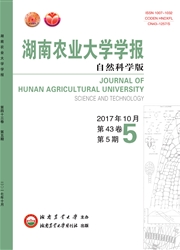

 中文摘要:
中文摘要:
选取云南水稻白叶枯病菌优势小种的代表菌株41个,利用从258个RAPD随机引物中筛选出多态性好的24条引物对其DNA进行多态性分析.指纹图谱和聚类分析结果表明,各优势小种间遗传差异较大,菌株间具有明显的遗传多态性,在不同的相似水平下可分为不同的遗传组群.水稻白叶枯病菌优势小种间在分子水平上存在明显差异,且遗传组群与小种间有对应关系,遗传距离为0.2时可以将41个水稻白叶枯代表菌株分为10个遗传相似组,其中第2、8、10组为主要组群,第2组包括14个菌株,主要为7号小种;第8组有9个菌株,全部为8号小种.
 英文摘要:
英文摘要:
The genetic diversity of 41 strains from preponderant races of Xanthomonas oryzae pv.oryzae was assessed by RAPD with 24 primers selected from 258 random primers. Dendrograms were generated from the combination data by using UPGMA analysis. The results indicated that extensive genetic variability among each predominant race of Xanthomonas oryzae pv.oryzae. The difference existed among predominant race ofXanthomonas oryzae pv.oryzae at molecular level. All strains could be divided into 10 groups at a level of 80% similarity. Group 2, 8, and 10 were predominant. Group 2 contains 14 strains, the strains are mainly belonged to 7 race. Group 8 contains 9 strains, the strains are all in 8 race, Group 10 have 9 strains. The result was radically in accordance with the conclusion from the regular response of rice differentials. RAPD analysis provided the proof of molecular level for the result of traditional method based on virulence analysis.
 同期刊论文项目
同期刊论文项目
 同项目期刊论文
同项目期刊论文
 期刊信息
期刊信息
